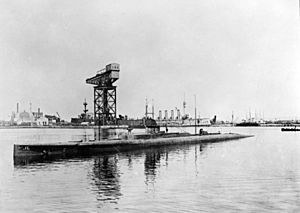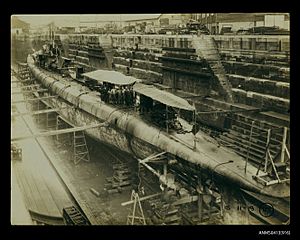HMS J1 facts for kids

HMAS J1 in 1919
|
|
Quick facts for kids History |
|
|---|---|
| Builder | HM Dockyard at Portsmouth in Hampshire |
| Launched | 6 November 1915 |
| Decommissioned | 12 July 1922 |
| Fate | Hulk scuttled |
| General characteristics | |
| Class and type | British J-class submarine |
| Displacement |
|
| Length | 275 ft (84 m) |
| Beam | 22 ft (6.7 m) |
| Draught | 14 ft (4.3 m) |
| Propulsion |
|
| Speed |
|
| Range | 4,000 nmi (7,400 km; 4,600 mi) at 12 kn (22 km/h; 14 mph) |
| Test depth | 300 ft (91 m) max |
| Complement | 44 personnel |
| Armament |
|
HMS J1 (later HMAS J1) was a special type of submarine called a J-class. It was used by the Royal Navy (Britain's navy) and later by the Royal Australian Navy. This submarine was known for being very fast for its time and played a role in World War I.
Contents
Building a Submarine: The J1's Design
The J-class submarines were designed by the Royal Navy. They were built to be faster than German submarines that had been reported. J1 was a large submarine. It weighed about 1,210 tons when it was on the surface of the water. When it was underwater, it weighed about 1,820 tons.
Size and Speed
The submarine was about 275 feet (84 m) long. That's longer than two basketball courts! It was 22 feet (6.7 m) wide and sat 14 feet (4.3 m) deep in the water. The J-class submarines were unique because they had three propellers. No other British submarines had three propellers.
When J1 was on the surface, it used three powerful diesel engines. When it went underwater, it switched to electric motors powered by batteries. It could travel very fast on the surface, reaching 19 knots (35 km/h; 22 mph). This made it one of the fastest submarines in the world when it was built. Underwater, it could go up to 9.5 knots (17.6 km/h; 10.9 mph). It could travel about 4,000 nautical miles (7,400 km; 4,600 mi) (nautical miles) at a speed of 12 knots (22 km/h; 14 mph).
Weapons and Crew
J1 was armed with six 18-inch (450 mm) torpedo tubes. Four of these were at the front (bow), and one was on each side. Torpedoes are like underwater missiles. It also had a 4 in (102 mm) gun on its deck. This gun was first placed near the command tower. Later, it was moved to the front of the command tower for better streamlining. A crew of 44 people worked on the submarine.
J1 was built at HM Dockyard in Portsmouth, Hampshire. It was officially launched into the water on 6 November 1915.
J1's Time in Service
J1 spent its early service patrolling the North Sea. In November 1916, it had an important encounter. A group of German warships, including large battleships called dreadnoughts, were returning to port. They had been trying to rescue two German submarines stuck in fog.
A Brave Attack
On 5 November 1916, near Horns Reef, J1 spotted the German force. The submarine launched torpedoes at two of the large battleships, SMS Kronprinz and SMS Grosser Kurfürst. The torpedoes hit! The battleships were damaged but did not sink. They managed to reach port for repairs. For this brave action, J1's commanding officer, Commander N. F. Laurence, received a special award called a Bar for his Distinguished Service Order.
Later, J1 was moved to Gibraltar to operate in the Mediterranean Sea. On 9 November 1918, it used a special depth charge launcher during a fight with another submarine, UB-57. Depth charges are bombs that explode underwater.
After World War I, the British Admiralty (the British navy's leaders) wanted to protect the Pacific region. They decided to give six J-class submarines, including J1, to the Royal Australian Navy as gifts.
J1 and its sister submarines officially joined the Australian Navy in April 1919. They began a long journey to Australia on 9 April. They traveled with two Australian cruisers, Sydney and Brisbane, and a support ship, Platypus. The group arrived in Thursday Island on 29 June and in Sydney on 10 July. Because the submarines had traveled so far, they needed repairs right away.
J1 and another submarine, J4, along with Platypus, sailed to Geelong on 10 February 1920. A submarine base was set up there. The submarines were used for local training exercises. In 1921, they visited Tasmania. However, they were not used much after that. By June 1922, it became too expensive to keep them. Also, the economy was not doing well. So, all six submarines were taken out of service and prepared for sale.
The End of J1's Journey
J1 was officially taken out of service on 12 July 1922. It was sold to the Melbourne Salvage Company on 26 February 1924. The submarine was then purposely sunk, or scuttled, in a ship graveyard near Port Phillip Heads. This happened on 26 May 1926, at coordinates 38°18′58″S 144°33′13″E / 38.31611°S 144.55361°E.
Today, the wreck of J1 is known by divers as "38 Metre Sub" or "New Sub." It lies 38 metres (125 ft) underwater. Experienced divers can visit the wreck.


